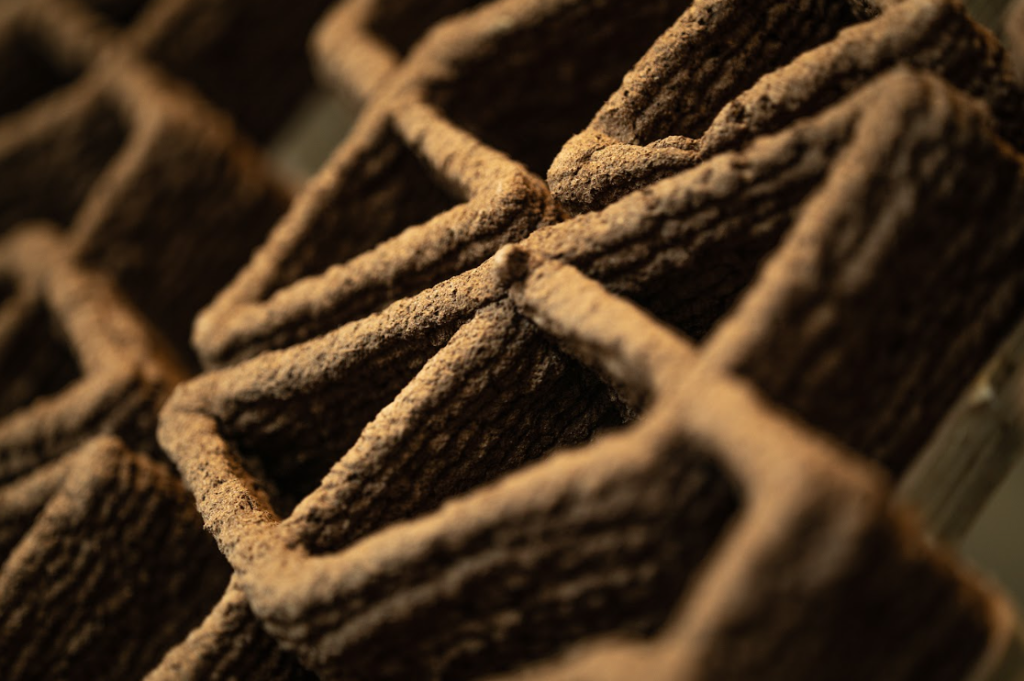Make your nominations for the 2023 3D Printing Industry Awards.
Combating waste wood’s environmental impact, Mexico-based company MANUFACTURA in partnership with La Metropolitana, a furniture manufacturing and design workshop has led an initiative named “The Wood Project” or “UN PROYECTO DE MADERA.”
MANUFACTURA highlights The Wood Project’s foundation lies in the methods grounded in wood’s inherent traits. This initiative addresses La Metropolitana’s daily production of 5-6 bags of sawdust, weighing 40 kg each. Envisioning a circular economy, this project repurposes these waste byproducts to craft 3D printed structures via a robotic arm, minimizing waste and environmental impact, and embracing a sustainable cycle.
What’s the outcome of this project?
Employing an extruder mounted on a KUKA KR-150 industrial robotic arm, the 3D printing process employs precise directions to deposit material, yielding complex, efficient, and sustainable structures. The material’s demonstrator focuses on three architectonic-scale partition walls, comprising 72 pieces measuring 20 x 20 cm. This fabrication occurred over a three-week period, encompassing both the 3D printing and drying stages.
The pieces easily replicate and assemble, allowing effortless element scaling. These bricks are sustainably produced in a circular manner, utilizing waste-sourced raw materials from La Metropolitana, processed for optimal sizing. Most sawdust is rich in cellulose, hemicellulose, lignin, and other substances desirable in industrial applications. Additionally, resulting components display remarkable lightness; each brick averages 207 grams, totaling 15 kg for the entire structure, says the company.
Collaborating with Mexico’s Autonomous National University (UNAM), the Laboratory of Materials and Structural Systems (LMSE) is actively engaged in material analysis. Through microscopic inspections and compressive tests, the material has been rigorously assessed. Under compression, the material’s limited flexibility led to pre-fracture failure due to defragmentation. Despite this, it demonstrated an average resistance of 836.5 kg and a maximum average resistance of 20.15 kgf/cm². These values are on par with fired clay bricks, which typically show resistances ranging from 13.34 to 39.50 kgf/cm². Further exploration and refinement are imperative to fully uncover the material’s properties and practical potential.

A sustainable solution to Mexico’s waste problem
Central to the project is the creation of a bio-composite centered on sawdust, primarily sourced from Mexico’s native Tzalam tree species. Tzalam wood, known for its appearance and high hardness, blends with organic binders and lime to form a humidity and fungal-resistant matrix. After thorough experimentation, it was determined that sawdust from specific machines, such as calibrating machines and CNC routers, exhibited optimal physical properties for 3D printing, says MANUFACTURA.
MANUFACTURA reports that Mexico faces a daily challenge with around 102,895 tons of generated waste. The Environment and Natural Resources Department indicates that only 9.63% of this waste is presently recycled, while a significant 83.93% is deposited in final disposal sites, contributing to pollution and environmental hazards. Concurrently, Mexico’s annual timber production reaches about 9 million cubic meters. Unfortunately, a substantial portion of this timber, specifically 45 to 65%, culminates as waste byproducts like sawdust, shavings, and bark, with minimal economic value.
With this in mind, The Wood Project’s objectives focus on revamping sustainability and construction methods. It involves extracting raw materials from various industries, creating biodegradable materials, and utilizing cutting-edge technology for efficient fabrication. This approach aims to turn waste into valuable resources, fostering sustainability and creating job opportunities.

Advancements in wood 3D printing
Hebrew University of Jerusalem researchers developed a wood-based 3D printing material that transforms into predetermined shapes. Comprising wood flour and plant extracts, the eco-friendly material warps as it dries due to fiber orientations. Though developed earlier, this material enables controlled moisture evaporation during deposition, allowing the material to form complex objects.
Researchers from the Massachusetts Institute of Technology (MIT) and the Charles Stark Draper Laboratory addressed deforestation by developing a method of 3D bioprinting wood-like materials. Leveraging living cells from Zinnia elegans plants, the method creates wood-like materials, potentially reshaping the production of custom shapes like furniture without tree consumption. Fine-tuning structure properties, such as density and stiffness, was achieved by adjusting growth chemicals. This innovation showcased how sustainability and design could intersect, marking a significant advancement in eco-conscious manufacturing.
What does the future of 3D printing for the next ten years hold?
What engineering challenges will need to be tackled in the additive manufacturing sector in the coming decade?
To stay up to date with the latest 3D printing news, don’t forget to subscribe to the 3D Printing Industry newsletter or follow us on Twitter, or like our page on Facebook.
While you’re here, why not subscribe to our Youtube channel? Featuring discussion, debriefs, video shorts, and webinar replays.
Are you looking for a job in the additive manufacturing industry? Visit 3D Printing Jobs for a selection of roles in the industry.
Featured image shows 3D printed structures using wood as a material. Image via MANUFACTURA.



